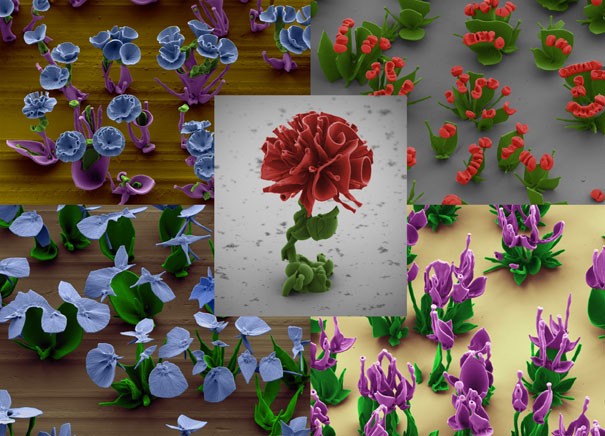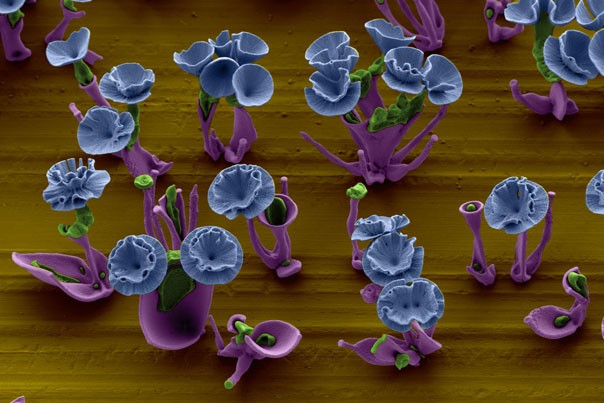It looks like you're using an Ad Blocker.
Please white-list or disable AboveTopSecret.com in your ad-blocking tool.
Thank you.
Some features of ATS will be disabled while you continue to use an ad-blocker.
11
share:
Cambridge, Mass. - May 16, 2013 - "Spring is like a perhaps hand," wrote the poet E. E. Cummings: "carefully / moving a perhaps / fraction of flower here placing / an inch of air there... / without breaking anything."
With the hand of nature trained on a beaker of chemical fluid, the most delicate flower structures have been formed in a Harvard laboratory—and not at the scale of inches, but microns.
These minuscule sculptures, curved and delicate, don't resemble the cubic or jagged forms normally associated with crystals, though that's what they are. Rather, fields of carnations and marigolds seem to bloom from the surface of a submerged glass slide, assembling themselves a molecule at a time.
By simply manipulating chemical gradients in a beaker of fluid, Wim L. Noorduin, a postdoctoral fellow at the Harvard School of Engineering and Applied Sciences (SEAS) and lead author of a paper appearing on the cover of the May 17 issue of Science, has found that he can control the growth behavior of these crystals to create precisely tailored structures.
You can really collaborate with the self-assembly process," says Noorduin. "The precipitation happens spontaneously, but if you want to change something then you can just manipulate the conditions of the reaction and sculpt the forms while they're growing."
Increasing the concentration of carbon dioxide, for instance, helps to create 'broad-leafed' structures. Reversing the pH gradient at the right moment can create curved, ruffled structures.
Noorduin and his colleagues have grown the crystals on glass slides and metal blades; they've even grown a field of flowers in front of President Lincoln's seat on a one-cent coin.
Harvard.edu
Pretty cool. I was thrown off when I first read this. It took me a sec to figure out they were so small. It is kind of a bummer at first I imagined I could one day give these to my wife. Kind of like the tiniest fiddle playing it wouldn’t go over well.
Important to also note that the original images obtained in the SEM are just black and white.
The colors have been photoshopped onto to these.
The colors have been photoshopped onto to these.
These false-color SEM images ...
Wow.
Those are really super pretty and awesome.
S+F!!!
Thank you for another wonderful thread.
Those are really super pretty and awesome.
S+F!!!
Thank you for another wonderful thread.
edit on 11/26/2013 by AliceBleachWhite because: (no reason given)
reply to post by alfa1
Aww you kinda ruined it for me. Oh well they are still cool.
reply to post by AliceBleachWhite
Your welcome Alice. I am recovering from another surgery so I will be posting a lot more threads. It sure beats watching TV.
Aww you kinda ruined it for me. Oh well they are still cool.
reply to post by AliceBleachWhite
Your welcome Alice. I am recovering from another surgery so I will be posting a lot more threads. It sure beats watching TV.
new topics
-
Let's talk planes.
General Chit Chat: 7 hours ago -
January 6th report shows disturbing trend (nobody is shocked)
US Political Madness: 8 hours ago -
Inexplicable military simulation - virtual reality showdown in the night..
The Gray Area: 9 hours ago -
The Truth about Migrant Crime in Britain.
Social Issues and Civil Unrest: 10 hours ago
top topics
-
Trudeau Resigns! Breaking
Mainstream News: 12 hours ago, 26 flags -
January 6th report shows disturbing trend (nobody is shocked)
US Political Madness: 8 hours ago, 20 flags -
Live updates: Congress meets to certify Trump's presidential election victory
US Political Madness: 13 hours ago, 12 flags -
The Truth about Migrant Crime in Britain.
Social Issues and Civil Unrest: 10 hours ago, 10 flags -
Gravitic Propulsion--What IF the US and China Really Have it?
General Conspiracies: 13 hours ago, 9 flags -
Let's talk planes.
General Chit Chat: 7 hours ago, 5 flags -
Greatest thing you ever got, or bought?
General Chit Chat: 13 hours ago, 4 flags -
Inexplicable military simulation - virtual reality showdown in the night..
The Gray Area: 9 hours ago, 2 flags
11


